The ecommerce world undergoes constant changes. Traditional ecommerce platforms strive to cope with recent demands, from the explosion of mobile sales to the growth of the Internet of Things.
What do consumers expect from ecommerce stores? Quality products, good prices, and a seamless shopping experience: a great user experience can be one of the most important ways for an ecommerce store to differentiate itself from the rest.
This context is a fertile ground for advancements and technologies driving ecommerce, like:
- Artificial intelligence that powers chatbots to become more human-like and remove burden from employees.
- Data analytics tools that assist in predicting trends and personalizing experiences.
- Blockchain, which protects transactions and streamlines their processing.
And that’s only the beginning.
One recent trend with real staying potential is headless commerce.
But many people wonder what is headless commerce? How does it help online retailers? In this article, we’ll cover headless commerce structure, its benefits, the challenges associated with it, and whether making the switch is the right decision for your business.
Let’s jump right in!
Headless commerce definition
Today, shopping doesn’t just happen on a desktop. It even goes beyond smartphones. Prospects use many different channels to order goods, including smart speakers, TVs, refrigerators, and more. These devices let you shop without distracting from everyday tasks or leaving your home.
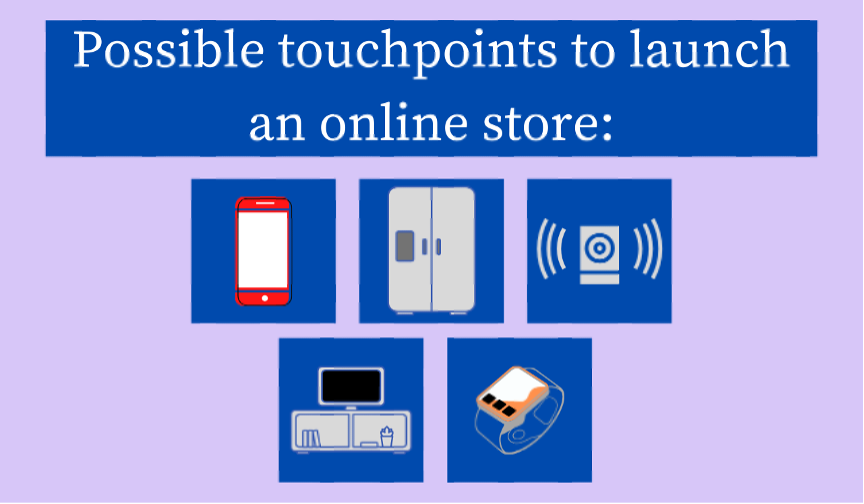
The increasing popularity of all these different touchpoints means headless commerce is really taking off.
On a basic level, headless commerce means separating the front end from the back end, which makes websites more agile and opens up the possibility to make great user experiences available on different shopping channels (“heads”).
With headless commerce, these two parts of the website become less dependent on each other. For example, developers can work on the front end (modify the button color or image placement) without making changes to the back end, which saves a lot of time and effort.
The front end and back end use APIs (application programming interfaces) as communication mediators. These pieces of code transmit information about what the front end or back end should do based on the users’ input.
Headless commerce requires modern frameworks (like ReactJS or AngularJS) to build the front end.
The next level of the headless commerce architecture involves the back-end division into microservices.
These are essential ecommerce website parts, like search, online catalog, shopping cart, and others, which operate in isolation from one another.
What is headless commerce vs. monolithic architecture?
To understand the difference, it’s important to know how traditional ecommerce websites work.
Unlike headless websites, monolithic websites have the front end and back end “glued” together. This is how coders developed most online stores in the past, and some continue to do it this way today.
Traditional ecommerce websites operate in a single environment, which means little flexibility. This arrangement leads to delays when it comes to updating a store or introducing new features. Developers have to move back and forth to ensure nothing breaks. Traditional websites are also more challenging to scale and configure for numerous touchpoints.
One of the main “under the hood” peculiarities of monolithic website architecture is the way the website works once users access it. Monolithic architecture implies server-side rendering as visitors move from one page to another. The server generates the HTML document for the browser to parse. The browser downloads all the needed content each time a visitor clicks a website link and server experiences more CPU usage due to repeated HTML generation. This can slow down the overall load speed.
Headless commerce, on the other hand, relies on client-side rendering. This means the client loads the HTML document with JS code, just once. Then, the unchangeable structure (like the header and footer) remains in the browser, with only new data coming from the back end.
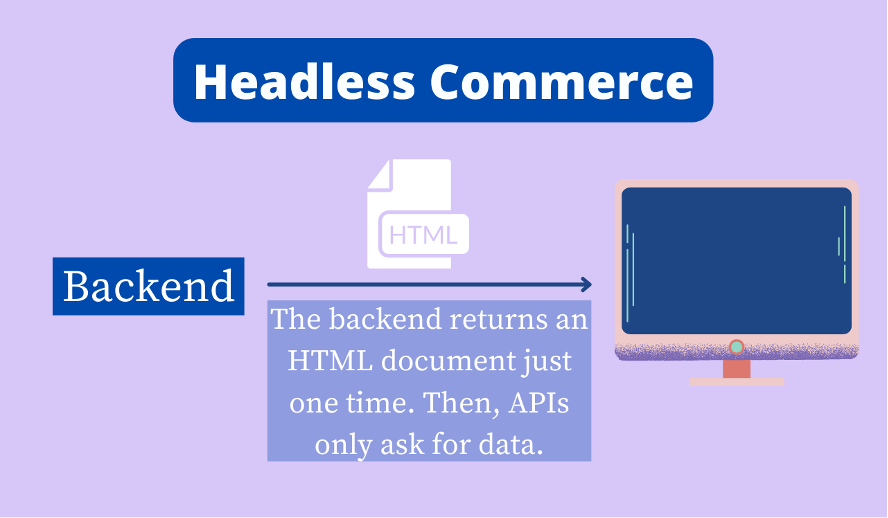
4 benefits of going headless for an ecommerce store
Now that we’ve talked about what headless commerce is, let’s see why you might want to consider making the switch.
1. Quick introduction of new features
Faster time to market is one of the main benefits of switching to headless. Monolithic architecture requires developers to cross-check whether the introduced changes are visible on the front end and back end (such as tags in the HTML).
Headless reduces the need for development work. APIs ensure the website’s agility, so you can omit the step of fine-tuning its two parts. Headless architecture also guarantees errors won’t disrupt the work of the resource.
Suppose you need to update one microservice. As other microservices exist separately, possible mismatches won’t bring the store to a halt. This means you can launch solutions faster, which helps you outperform competitors who may face frequent challenges when something breaks and affects the whole website.
2. Integrating numerous channels
As mentioned above, headless commerce makes it easy to create great user experiences on numerous touchpoints. It streamlines website development for touchpoints like TVs, voice speakers, voiceovers, and—of course—smartphones. Many of them will become more relevant in the future, but enhancing mobile UX is essential today.
Even if you’re not quite ready to move into “unconventional” shopping channels, headless can do a lot to improve your mobile version.
And that’s worth thinking long and hard about: mobile commerce is booming. Insider Intelligence predicts that mobile will account for 42.9% of all ecommerce volume in 2024. And it’s not hard to see why… almost everyone owns a smartphone, screen sizes are increasing, and native apps make browsing goods and placing orders more convenient.
To attract more visitors to your ecommerce website, you want to ensure it’s mobile friendly and loads fast. Moving to headless can help with this.
Headless commerce enables brands to create a progressive web application (PWA). This type of web app has a native app appearance but works from the browser. So it’s a website with polished UI/UX, rapid loading, and the ability to send push notifications.
This allows you to improve the UX on the three most widely-used touchpoints: smartphones, PC/laptops, and tablets. Plus, you’ll get a head start on preparing the website to connect to more touchpoints down the line.
Check out what a PWA might look like in the example below, from Sophie Conran’s online store.

3. Flexibility and scalability
The flexibility of headless commerce is another important advantage.
This structure lets you integrate solutions, like websites and apps, into the headless commerce solution, ensure an elevated mobile experience (with progressive web apps), and solve isolated problems without disrupting overall website operations.
Headless architecture follows a modular strategy, which means you can choose what to add, remove, replace, or leave alone—without having to restructure completely. This flexibility helps you adapt more quickly to things like:
- changing ways of shopping,
- competitors entering the market, and
- the need to scale your business to international clients.
As your company and your needs evolve, you can modify the IT stack over time. A headless system is advantageous precisely for its increased agility.
4. Unparalleled shopping experience
Headless websites are more likely to have higher conversion rates. Why? Because they offer speedier content delivery due to the architectural peculiarities and the method of data transmission.
Since content appears on the screen faster, headless commerce leads to greater user satisfaction, increased conversions, and a reduced bounce rate. Plus, the loading speed and positive website metrics influence the rankings on Google, so you’ll also boost your store in search results.
What are the challenges of headless commerce?
The move to headless commerce isn’t for everyone: to make it work, you’ll need time, money, and resources.
A headless architecture better suits large enterprises who want to expand customer reach to innovative platforms, scale the business, and quickly add new features. Usually, these are companies who’ve been on the market for some time and have a functioning website.
If you already have a monolithic solution, you’ll need to transform it by splitting the front end from the back end. That’s not fast… and it takes even longer if your existing store already has many custom features.
Building a headless website from the ground up also requires many developers’ and designers’ hours. You may also need to create several UI/UX designs for different devices, so both departments should work together to ensure the store has a user-friendly layout for various front ends.
On a more positive note, you don’t have to do it all at once. You can do it step by step, or pick a ready-made headless commerce solution.
Top 10 headless commerce platforms to consider
1. Magento 2 (Adobe Commerce)
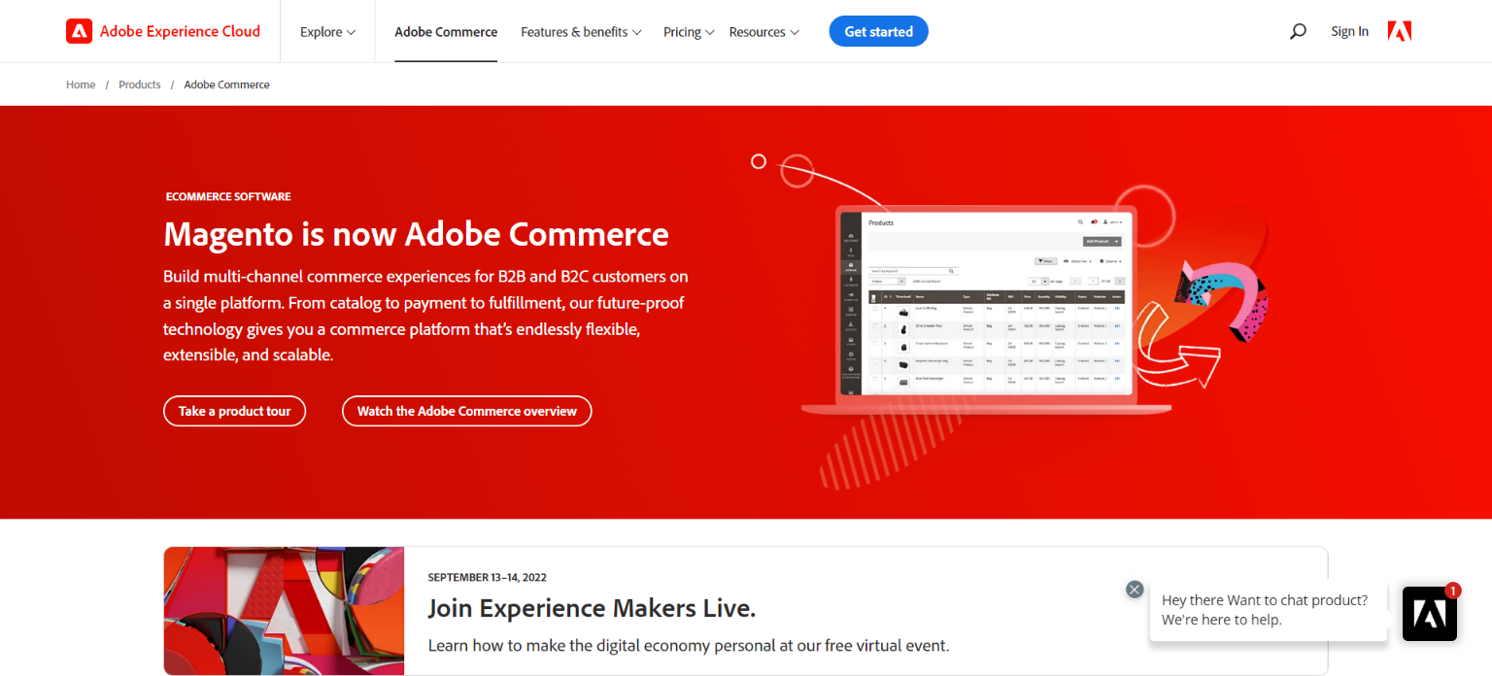
Magento is a popular ecommerce platform for developing highly-customized online stores. It’s open source and now belongs to the Adobe group. It also offers a paid and hosted version with the price depending on the Gross Sales Revenue (GSR).
The company supports a headless commerce system and GraphQL as an API. You’ll need to upgrade Magento to version 2.3 at least to access this functionality. You can also build a progressive web application with a ready-made PWA Studio.
2. Shopify Plus
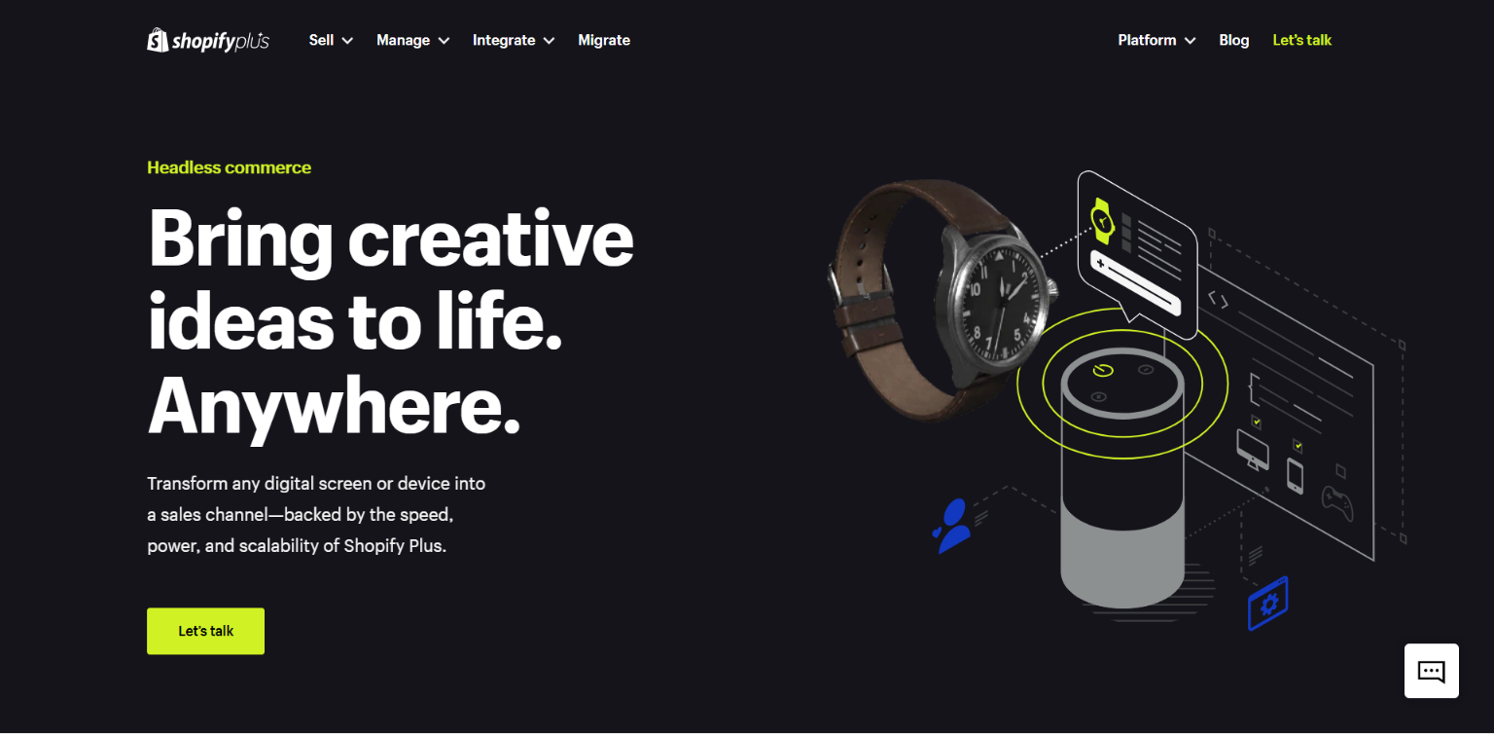
Shopify is a SaaS platform that’s become famous for how easy it is to launch an online store on it. You don’t need to worry about hosting or other headaches, as it’s all cloud-based. You simply pay for this solution monthly to unlock its features—which is exactly why Shopify is so widely used among small and medium online stores.
The company opens up opportunities for headless commerce in its Shopify Plus version. This is aimed at large stores, allowing them to customize the shopping experience according to the channels used. The platform provides an easy-to-use admin panel, and you can easily integrate it with many popular solutions, like your CRM or CMS.
3. BigCommerce Enterprise
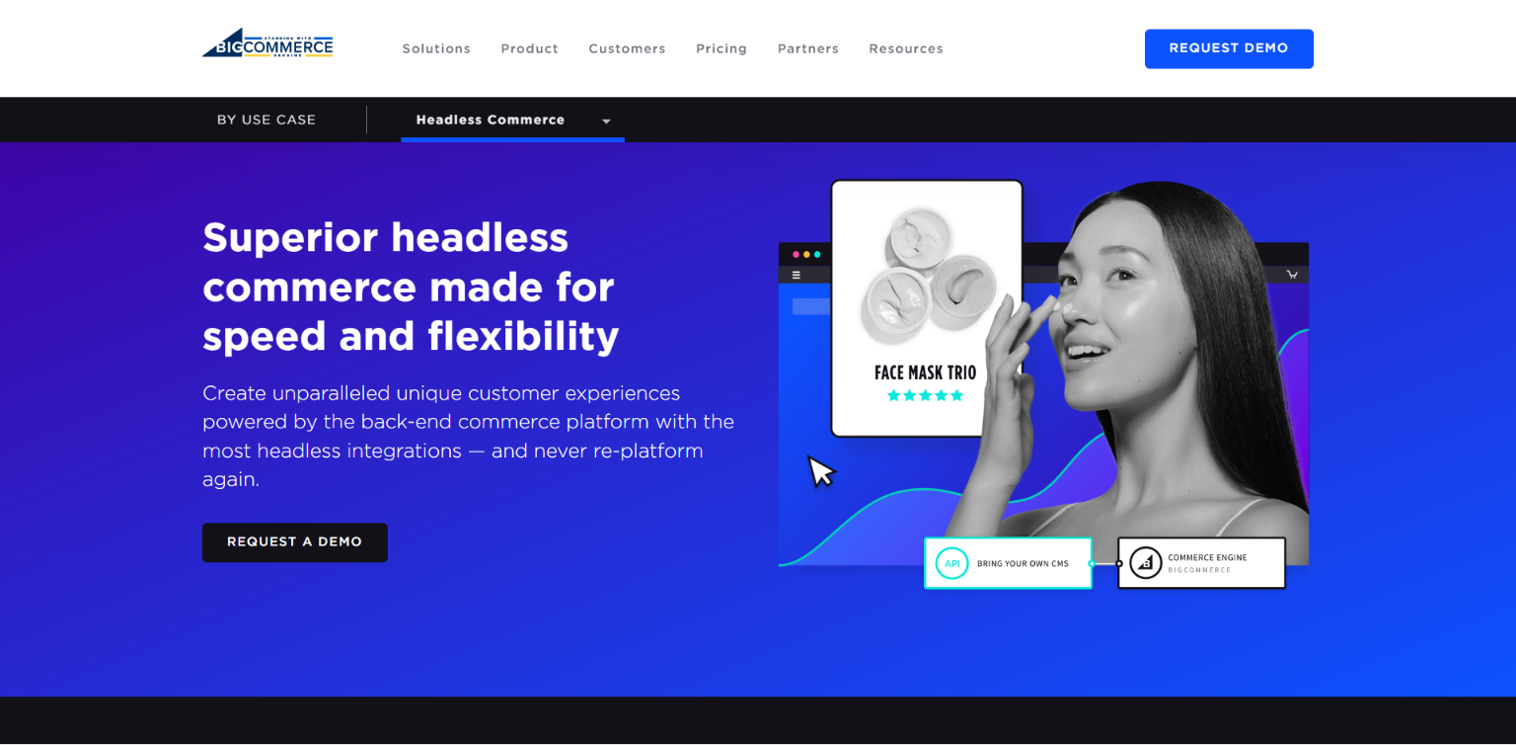
BigCommerce is another platform made for ecommerce sites of all sizes. It provides numerous customization options and templates, enabling developers to edit their HTML and CSS code. It’s also a SaaS company, so you don’t need to worry about hosting.
This platform supports Next.js, Gatsby.js, and Nuxt.js as frameworks for creating front ends. It also comes with adaptable APIs and a multi-storefront option to expand to new markets or introduce several brands. BigCommerce is compatible with other content management systems and digital experience platforms.
4. Commercetools
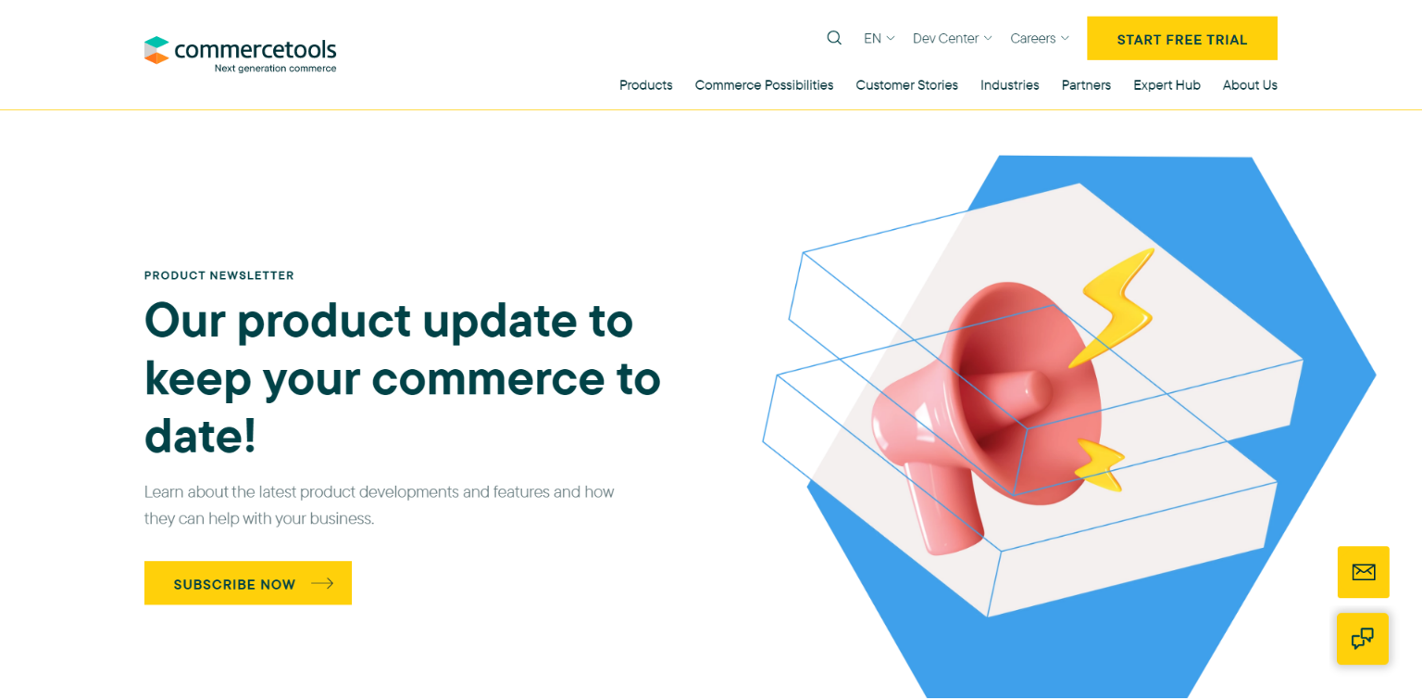
Commercetools is one of the most well-known headless commerce platforms. It’s built on “modernMACH principles,” (Microservices, API-first, Cloud-native, and Headless). This headless commerce system enables retailers to customize user experiences to meet their needs.
The headless eCommerce platform, built on PHP and MySQL, incorporates PHP benchmarks to ensure optimal performance in constructing store experiences tailored to the target storefront. Through benchmarking, the platform’s efficiency in handling storefront separation and API responses is meticulously evaluated and optimized for rapid and reliable service delivery.
While you may opt for Commercetools when switching to headless commerce, it’s worth pointing out that this solution requires you to build and integrate more tools and features in addition to the existing ready-made commerce building blocks.
5. Salesforce Commerce Cloud
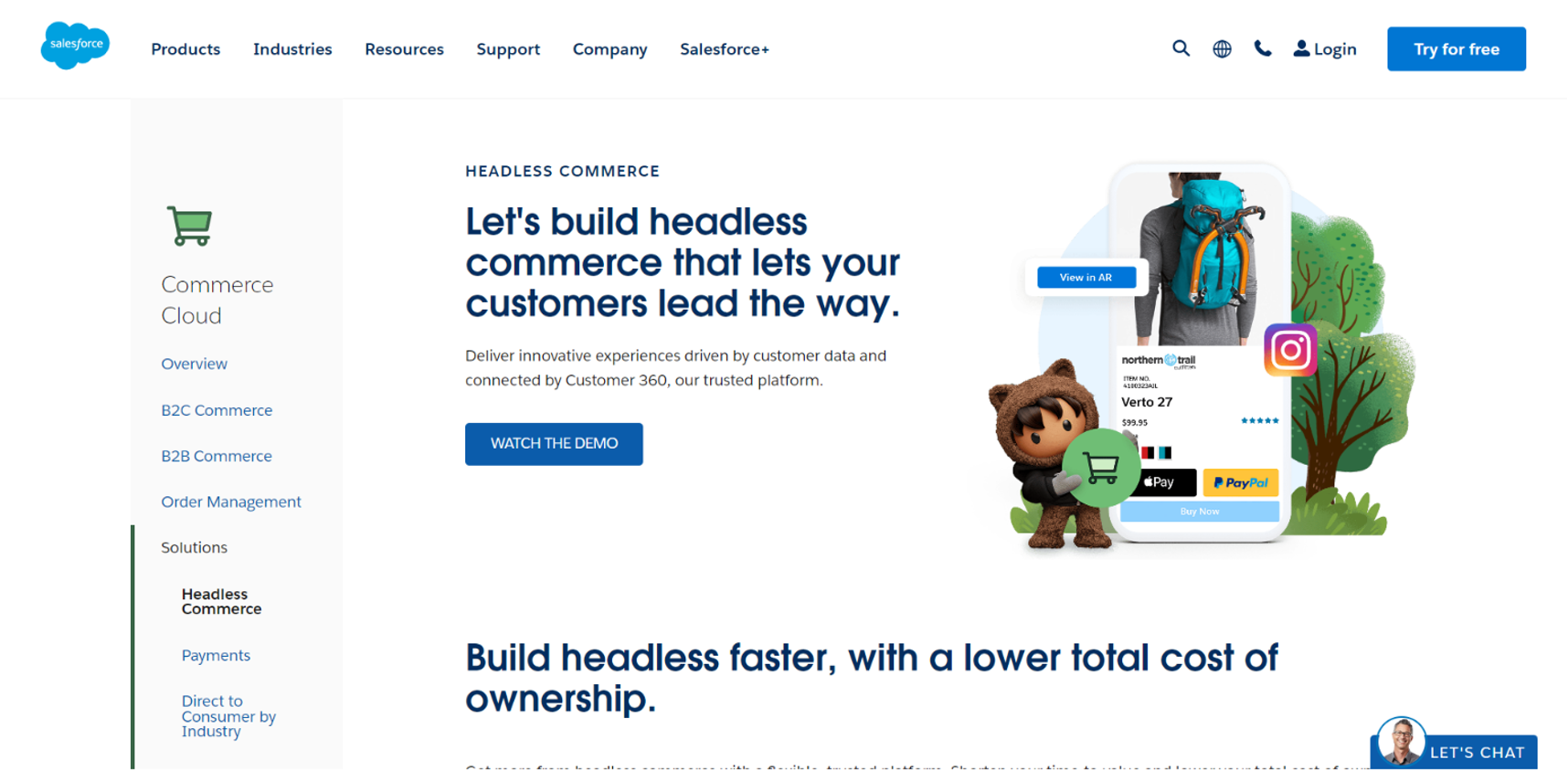
Salesforce Commerce Cloud is one of the products in Salesforce’s suite. Known for its scalability, this SaaS headless ecommerce system is perfect for enterprise-level businesses. It’s cloud based and offers best-in-class features and capabilities.
You can enhance customers’ online shopping experience by adopting Salesforce API-first commerce. Additionally, ecommerce businesses can use the company’s library of prebuilt connections to improve their websites and create mobile applications.
Note that Salesforce Commerce Cloud may cause difficulties if you want to incorporate technologies outside the branded suite. You may also need to set aside more time for onboarding. However, it will pay off in the end, as you’ll gain the ability to create fantastic front-end user interfaces and stay flexible with all the Salesforce-powered back end features.
6. Elastic Path
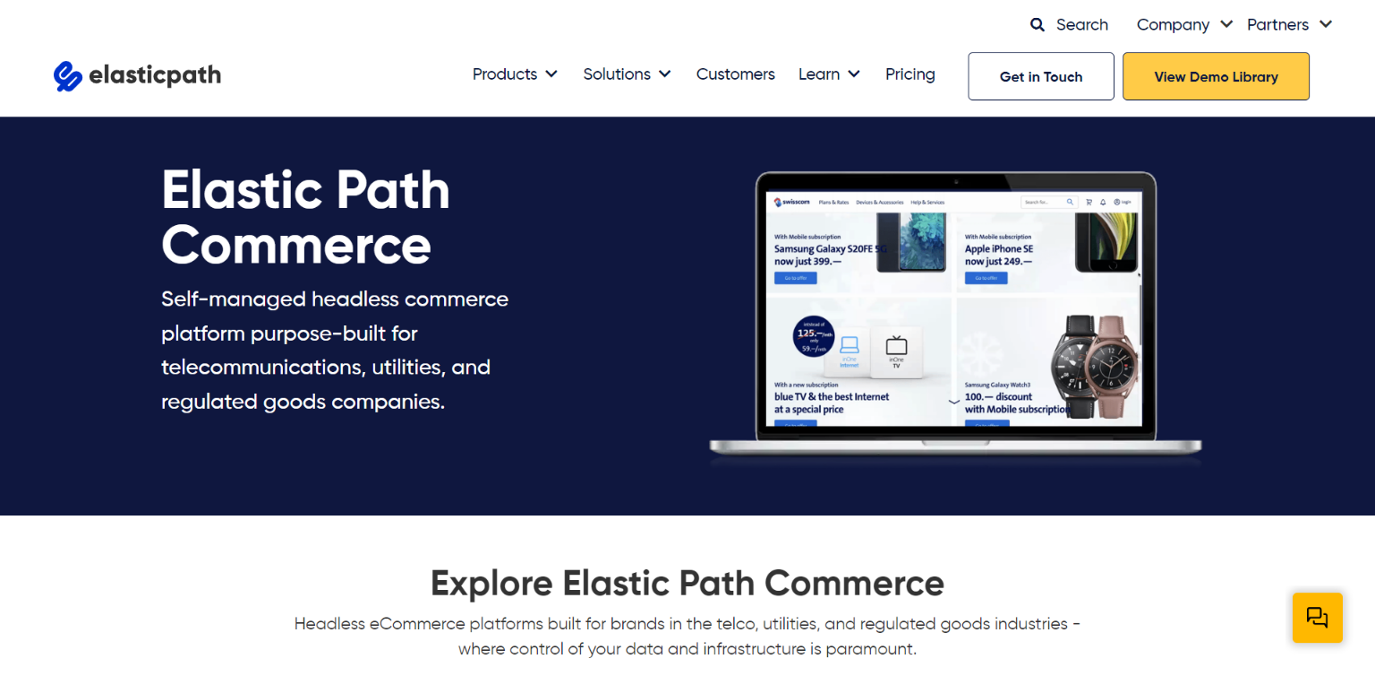
Elastic Path is one of the top open-source software packages. It focuses on commerce solutions for enterprise-size businesses. Its foundation in Java and Apache enables the delivery of extremely quick storefronts via APIs. Being a complete, ready-to-launch solution, this headless ecommerce platform helps eliminate the complexities associated with going headless.
Elastic Path combines the robust capabilities of a traditional ecommerce platform with the agility of headless architecture. It offers technologies like PWA, AR experience, and Facebook chatbot, and it also facilitates omnichannel commerce for store owners to ensure memorable digital experiences across all touchpoints.
The platform can link to additional tools in the commerce tech stack, like ERP systems, search and merchandising tools, and more. On the downside, it lacks detailed documentation and guidelines, which means Elastic Path can be difficult for beginners to use and customize for their specific business needs.
7. Spryker
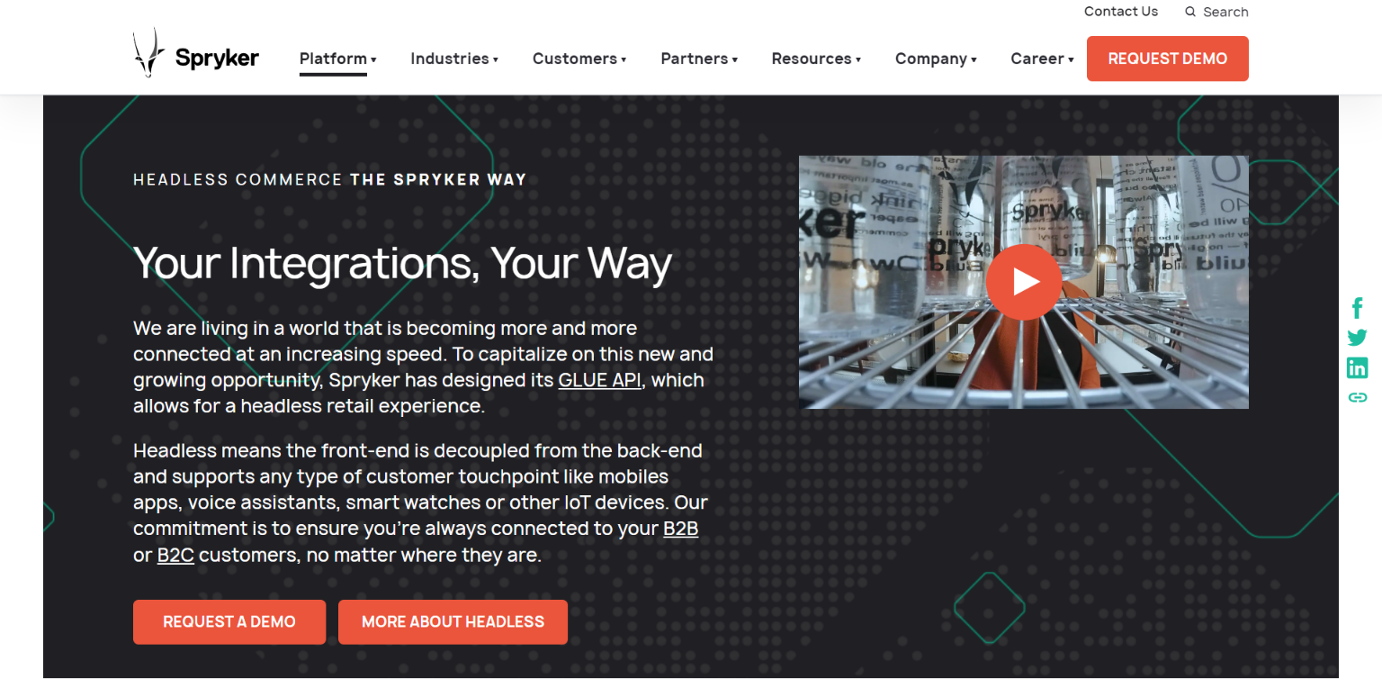
Spryker Commerce Cloud is a Platform as a Service (PaaS) product with a composable, API-based architecture. It’s another well-known open-source headless commerce platform for mid-sized and large businesses. It provides first-rate commerce solutions, including:
- Composable Commerce,
- Packaged Business Capabilities (PBCs),
- Spryker FeS (Frontend Enablement Service), and
- Headless Commerce, to name a few.
Spryker values flexibility and integrations as a vital part of modern commerce. It embraces API-first design and a headless approach to tailor them to company and customer needs.
The company offers advanced tools like its Glue API and Spryker LINK Middleware. Using these tools, you’ll gain the ability to connect voice assistants and other points, integrate your store with “smart shelves,” and more. Overall, Spryker is a powerful, highly customizable solution.
8. OroCommerce
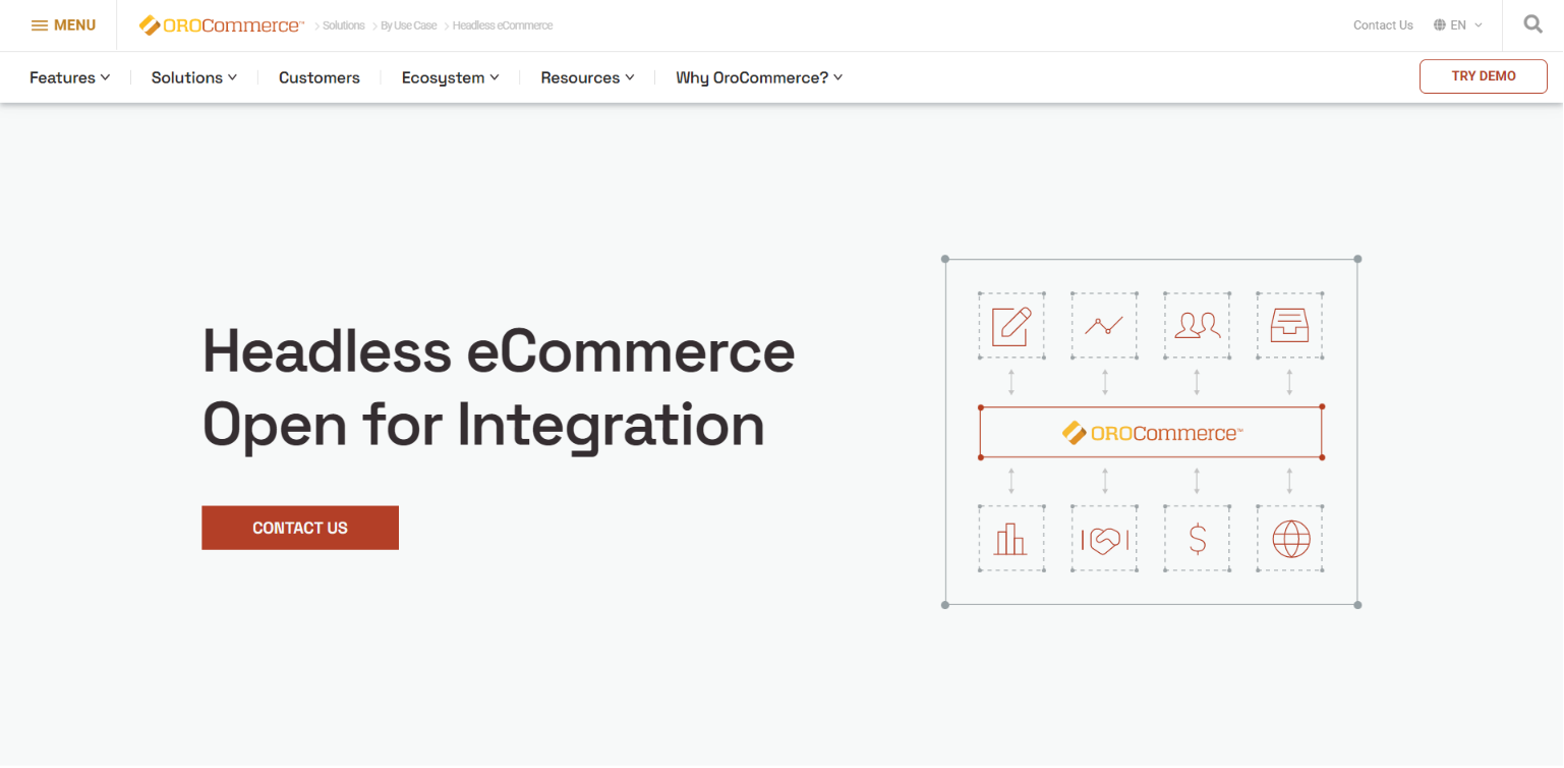
OroCommerce is an open-source headless commerce solution built primarily for B2B companies. The company provides specific features for this segment. It’s aimed at retailers, wholesalers, distributors, and brands working at the mid or enterprise level, but you can alter the platform to meet any B2B, B2B2C, B2B2B, and B2C eCommerce requirements.
OroCommerce was created by Magento developers and then sold to eBay. It’s built on PHP & Symphony and supports customization and integration with numerous solutions through APIs. Since the company has a deep understanding of B2B needs, it provides the following features:
- automation and customizable workflows,
- advanced reporting and pricing engines,
- access controls and permission configurations,
- personalization and localization, and
- integration with warehouse management systems, third-party logistics, enterprise resource planning, product information management, and other widespread business solutions.
The inventory management tools in OroCommerce help you manage several websites and warehouses. You can easily customize catalogs and change prices. The platform supports both traditional and headless commerce and lets you build seamless desktop and mobile experiences. It has an active community, where users are proactive in helping one another.
9. Swell
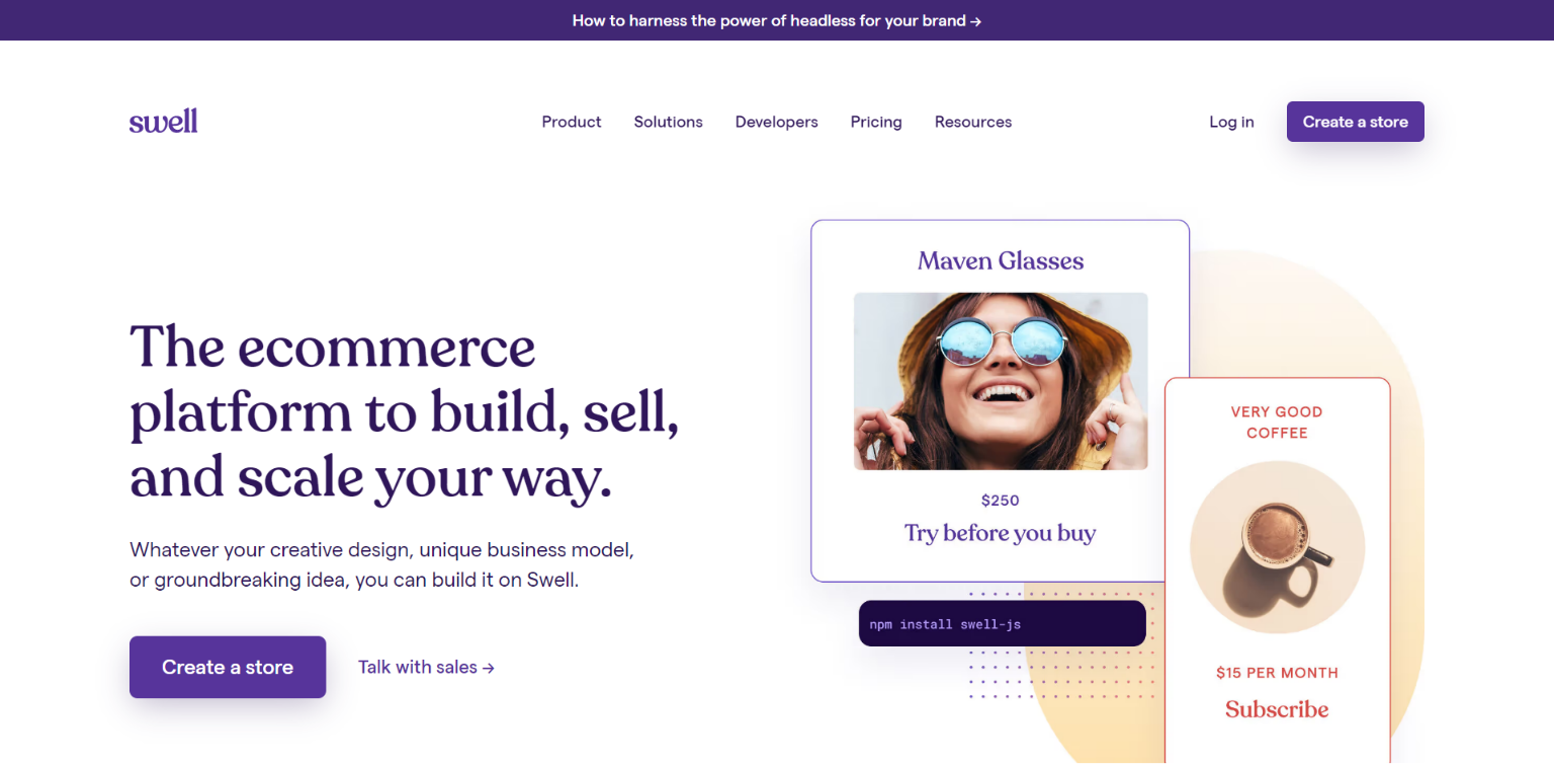
Swell is a rapidly-expanding headless commerce platform that boasts extensive customization. It doesn’t require you to be a professional developer to ensure a unique shopping experience. Swell provides the benefits of a hosted solution, such as a fast start and ready-made themes. At the same time, you have unprecedented freedom to customize.
Swell relies on the API-first philosophy. It also comes with an admin dashboard to manage online store operations, orders, inventory, customers, content, etc. It has an intuitive user interface and contains tools for accessing and manipulating store data and learning about the system. You can customize the dashboard to access advanced capabilities.
The platform also lets you configure product options quickly and easily. Swell allows you to manage product specifications, like color or size, or introduce personalization for higher conversions. The best part is that you can do all of this without any plugins or complex code.
10. SpreeCommerce
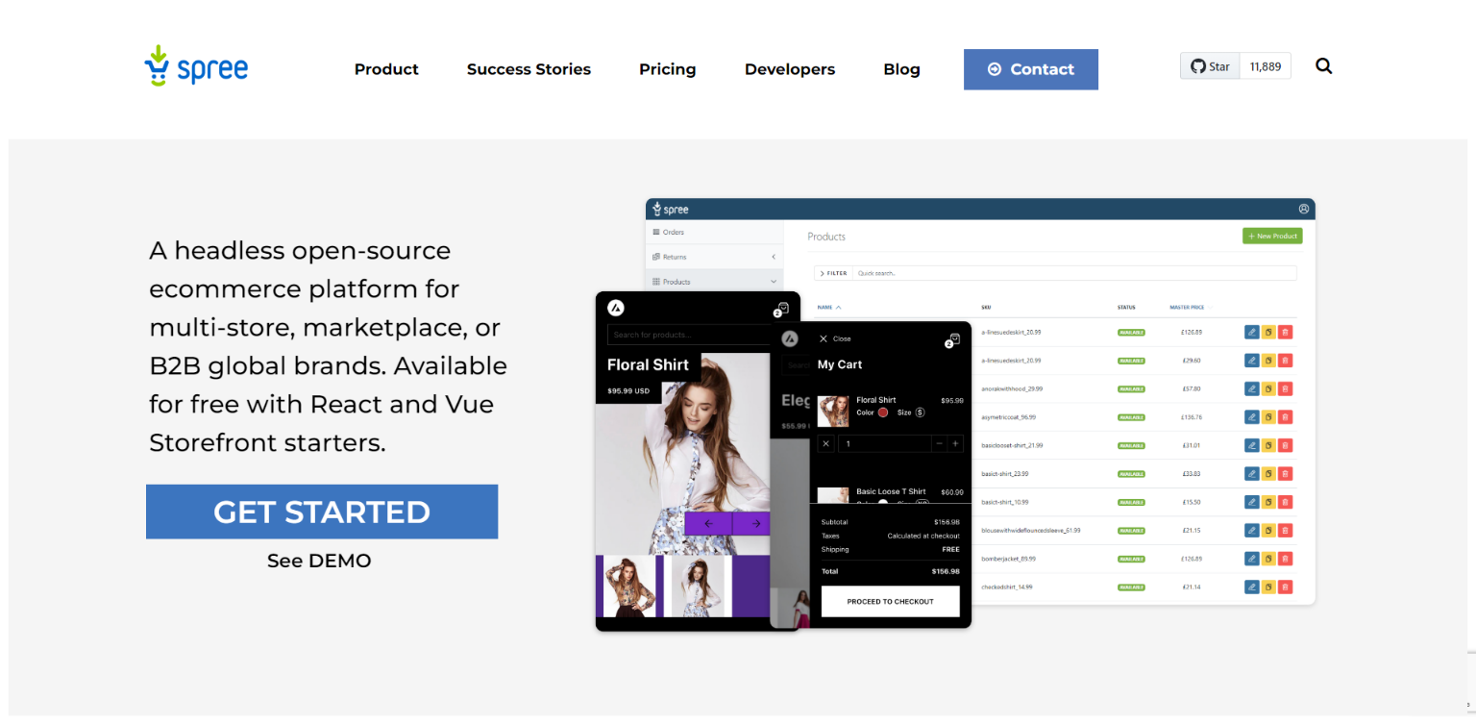
SpreeCommerce is another well-known open-source headless commerce platform with a focus on B2B. The solution offers a headless approach, multilingual and multicurrency support, product recommendations based on individual users’ interests, etc. This range of features allows international companies to create dynamic storefronts with maximum flexibility and customizability.
As it’s an open-source platform, SpreeCommerce is free and adaptable. However, you’ll need to be a power user to build and customize it to the fullest extent or to implement certain standard features. SpreeCommerce also has a limited number of themes. Technical support is available through forums and documentation on the web.
Spree also provides Spree as a Service, which is a cloud-based headless commerce solution that combines SaaS benefits with complete open-source features.
Headless commerce platform: Over to you
Do you need to go headless or not? The answer depends on what you want to achieve. Headless commerce helps huge online stores handle many touchpoints and excel at providing a flawless shopping experience. The transition to headless takes time, money, and resources, but it will likely pay off in the long run.
Headless architecture will continue to be a massive trend in upcoming years. As ecommerce competition intensifies, online merchants are forced to seek fresh opportunities. Why not take the first step toward this disruptive architecture before your rivals? If you have some thoughts on headless commerce potential, feel free to leave a comment below!
Share this
Written by

Kate Parish
Kate Parish, chief marketing officer at Onilab with 8+ years of experience in Digital Marketing and website promotion. Kate always strives to stay in pace with the ever-advancing online world and the sphere of Magento PWA development. Her expertise includes in-depth knowledge of SEO, branding, PPC, SMM, and the field of online sales in general.












